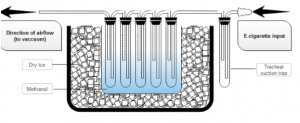In a recent study published online Aug. 13 in the BMJ journal Thorax, hoping to discover what happens when e-liquid evaporates and enters the lungs, researchers attempted to recreate vaping using common respiratory suction “traps” and collected the resulting condensation. Using unflavored eliquid both with and without nicotine to conduct the experiment.
They used alveolar macrophage cells (protective cells that fight and eat up debris such as bacteria, dust particles and allergens) from the lungs of eight, healthy non-smokers and grew them in petri dishes, then dosed a third with the raw e-cigarette liquids, and another third with different strengths of the collected vape condensate with or without nicotine. A control group of cells was left untreated.
Based on their findings, the researchers expressed concern that vaping isn’t as safe as some would like to believe.
Dr. David Thickett, lead author of the study and professor of respiratory medicine at the University of Birmingham, said “if you vape for 20 or 30 years and this can cause COPD, then that’s something we need to know about.”
“I don’t believe e-cigarettes are more harmful than ordinary cigarettes,” he continued. “But we should have a cautious skepticism that they are as safe as we are being led to believe.”
Bruce Nye, RN, President of Board of Directors for The Consumer Advocates for Smoke-free Alternatives Association (CASAA), agrees that smokers, vapers and non-smokers alike should be made aware of any possible risks involved with vaping, but disagrees with the authors’ conclusion that what they saw happen in a petri dish and plastic tubing has much relevance in the real world.
“I take issue with several aspects of this study,” said Nye. “the first being that, contrary to what the authors claim, we don’t actually hear that vaping is “safe.” Advocates only ever mention safety in relation to smoking combustible cigarettes, which is something this study fails to acknowledge.”
“Vaping is a harm reduction method intended for smokers, not as a hobby for non-smokers. A recent study published in July found that these products are by and large used by current smokers. Therefore, it’s important to compare the differences between vapor exposure and smoke exposure, not just vapor exposure and no exposure.”
“As for the study itself,” he continued, “it’s important to note that in-vitro studies do not correlate well with in-vivo studies. This is well-documented in cancer cure studies,” he explained, “where a reaction from isolated cells in a lab doesn’t happen the same way in the human body.”
Nye also explained that the methods used by the researchers to produce the vapor, and the length of exposure, were not realistic.

“They used a new and unproven collection method and a dry ice, methanol bath to create a condensate of the vapor that passed through the chambers. This is quite different than what the human body actually does,” Nye explained. “In effect, the experiment is the equivalent of inhaling and never exhaling!”
“Additionally, they gave the cells a continuous 24 hour exposure. Time of exposure is a huge factor in determining dosing, as well. Average vapers inhale 2.5 – 3 seconds of vapor then exhale. At a 30 second cycle over 5 minutes, that would represent at most less than 1 minute of actual potential exposure. In the experiment, they used the equivalent of 3 – 4 times that exposure. This is significant, because no matter how hard one tries, there is no way to expose yourself to e-cigarette vapor continuously, let alone at the concentrations used for this study.”
He also pointed out that, in general, a pro-inflammatory response is not a bad thing – it is evidence that the body is doing what it is supposed to do with foreign substances – so the presence of inflammation is not a conclusive indication that a disease will develop. It could just as easily be true that the inflammatory response is protecting the body from becoming diseased.
“And one key bit of information mentioned then completely glossed over in the paper,” Nye added, “is that n-Acetyl cysteine (a drug that is used to treat COPD) reverses or reduces the negative effects! This compound is also a part of the body’s natural defense mechanism (made from your own amino acids in small quantities) and would likely help mitigate any potential effects, further reducing the resulting toxicity.”
While this particular study was lacking in many ways, Nye agrees with the study authors that further research is needed to fully understand the effects of e-liquid exposure in humans.
“Most of these studies are lacking the basic, fundamental, validation needed to make their results meaningful to the population,” he said. “There is much work to be done to properly characterize the true respiratory exposure profile before real risk analysis can be conducted.”
Photo Credit (Featured social media image of man vaping): Vaping360.com
This article was originally published at CASAA
Author: KNoll-Marsh
